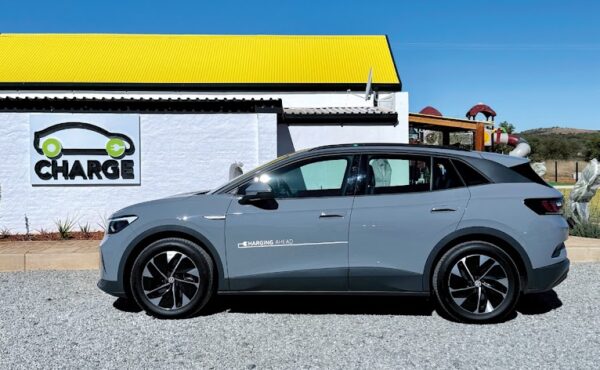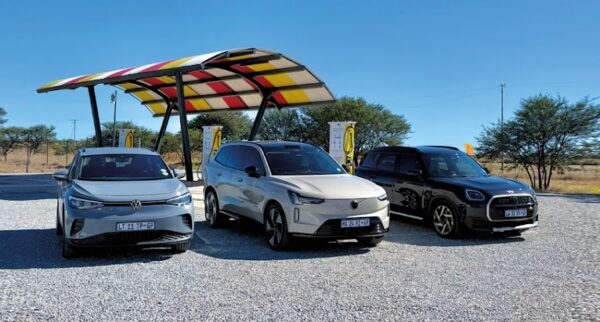Zero Carbon Charge’s EV stations will soon be coming to a major highway near you.

Looking at the Google map of the proposed EV charging stations from Zero Carbon Charge, there are no less than 120 pins marking the sites on national and secondary roads. Charge’s vision is to roll out a countrywide network of solar EV charging stations, and if you’re on a national road, there’ll be one every 150km. It received a R100mn equity investment from the Development Bank of Southern Africa (DBSA) in May, which, as co-founder Joubert Roux says, will unlock the N3 and N1 highways for EV drivers.
Charge has also signed a Memorandum of Understanding worth R1bn with Chinese energy storage systems manufacturer Shanghai Magic Power Tech and local partner Greencore Energy Solutions for the solar EV super chargers.
The company launched its first EV charging station in Wolmaransstad in the North West last November. The station has a small restaurant and an awning over the six 240kW EV chargers, which are the country’s fastest.
Charge’s next two locations will be on the N3; one will be approximately 184km from Johannesburg at the Reitz/ Roadside Road intersection, and the other 160km away near Winterton, at the Colenso turnoff. Construction on both sites began in July, and will be followed by a station at Matjiesfontein on the N1.
Roux says the first phase of its rollout will cover 60 sites at 300km intervals, a range that most EVs can cover on a single charge. The second phase will position the remaining 60 charging stations 150km apart.
The company’s value proposition is that it’s not dependent on Eskom, says Roux. “Our model operates independently, using solar PV arrays, largescale battery storage, and backup generation, which provides 24/7 energy availability, even at night or in poor weather conditions,” he says.
Road trip
I drove to Wolmaransstad recently in a Volkswagen ID.4 Pro, along with Greg Cress, Accenture’s principal director: Automotive & eMobility, who was in a Volvo EX90, and motoring journalist Brenwin Naidu, driving a Mini Countryman SE. We started off with a top-up charge at The Pantry service station in Rosebank in Johannesburg, and then stopped for a comfort break and battery level check at Potchefstroom. We all reached Wolmaransstad comfortably without a recharge.
We charged our cars at the same time in Wolmaransstad and the ID.4 Pro and EX90 averaged between 60kW and 75kW, while the Countryman pulled 30kW. EVs typically charge between 20% and 80% in 30 minutes, but after the EX90 was disconnected at 90% – because of its massive 111kWh battery – only then did the Countryman peak at 75kW. Cress says when there are multiple EVs connected to a charging station, the power gets distributed among the chargers, a bit like a fair use policy, so that each car gets an equal amount of the available power.

The cost per kilowatt at the Charge station came to R9.15, compared to the GridCars rate of R5.88 per kWh on AC charging, and R7.35 on DC.
Roux says its charging price is higher at the moment because it owns all the assets on its sites, “but our price will remain the same as we are not subject to Eskom’s inflation”.
Charging time
The Charge sites aren’t listed on the GridCars Live Map, but Roux doesn’t think this is a problem because drivers can use its app or find its stations on Google Maps. While the EVs charged, we ate at the onsite restaurant called Farm Flair Deli & Grillhouse. Charge has a partnership with the chain, and Cress, from Accenture, says Charge is trying to build a new experience around the needs of an EV driver.
“If I need to stop for a minimum of 30 minutes for a high-speed charge, I want to know what other services it can provide, so it’s not seen as a wasted 30 minutes, but rather time used in a pleasurable way.”
Charge’s conundrum, says Cress, is that it’s building a network of EV charging stations for a market that doesn’t yet exist. There’s also the matter of drivers being confident that they can charge their cars on long journeys.
“South Africa desperately needs EVs with ranges of 300km to be under the R400k mark, in order for us to move towards the 5% inflection point,” says Cress. When EVs reach 5% of all vehicles sold, exponential growth kicks in, he says, adding that Accenture has seen this in other markets.
Residential solar company GoSolr predicts that annual EV sales will reach 21 900 by 2030.
“We’re seeing a shift from high-end EV models to more accessible options, and this is growing, including in public transport,” says GoSolr CEO Andrew Middleton.
He believes the annual EV sales figure of over 1 200 EVs sold in South Africa in 2024 is underreported, and says it’s closer to 3 500 units, citing BYD among brands that don’t report sales figures to Naamsa.
Middleton says it’s only a matter of time before EVs become “very affordable” in South Africa. “And if you’ve got excess solar power at your house that you’ve already invested in, you’re effectively filling up your car for free.”
This article appears in the August issue of Brainstorm magazine and online.
Nafisa Akabor
Related posts
ABOUT

Recharged is an independent site that focuses on technology, electric vehicles, and the digital life by Nafisa Akabor. Drawing from her 18-year tech journalism career, expect news, reviews, how-tos, comparisons, and practical uses of tech that are easy to digest. info@recharged.co.za





